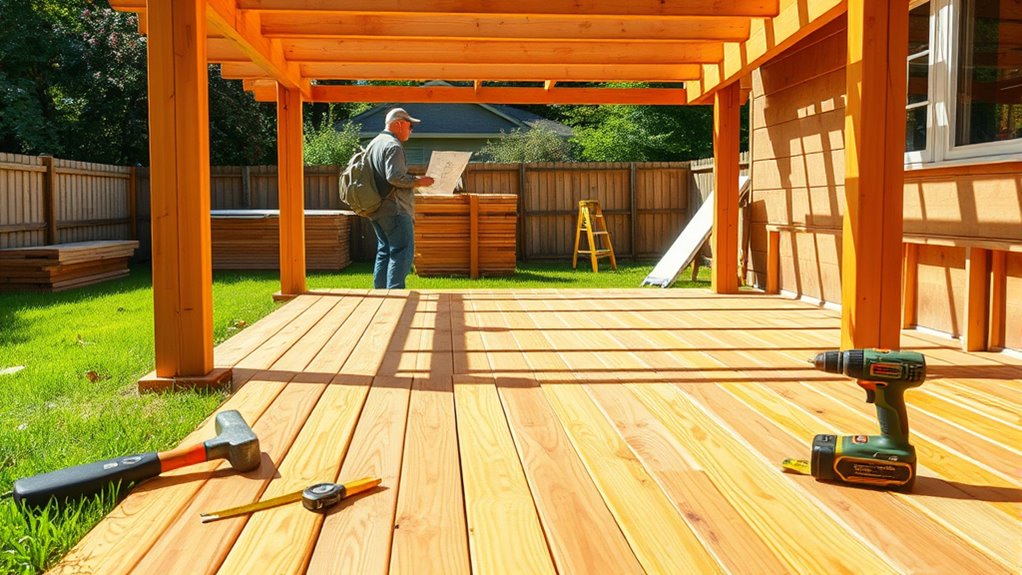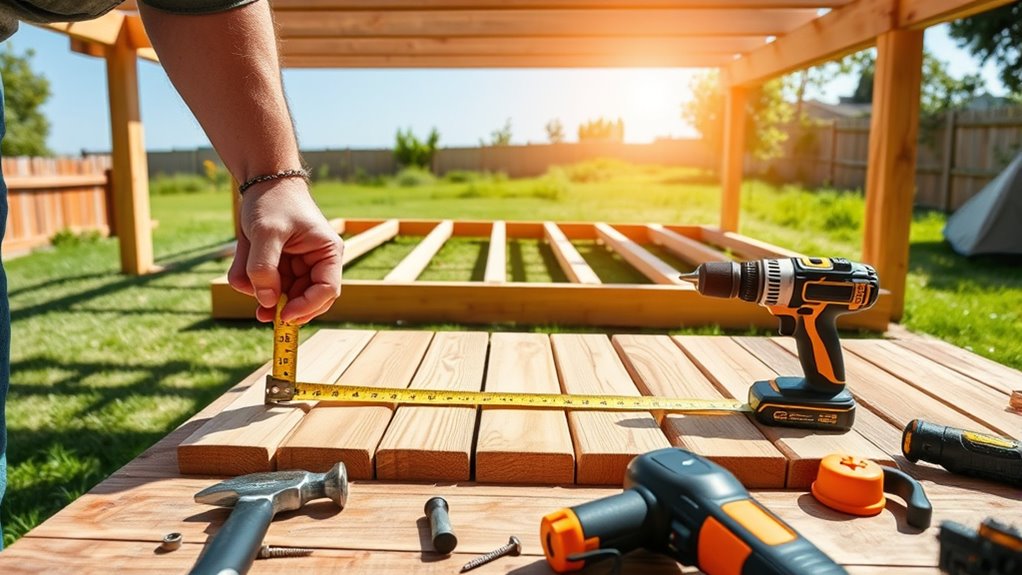To build a deck as a beginner, start by planning carefully—consider how you’ll use the space, then check local codes and permits. Gather the right materials, including durable lumber and weather-resistant hardware, and prepare the site by marking and leveling the ground. Follow best practices for framing, foundation, and surface installation, and prioritize safety with proper railings and spacing. Keep learning as you go; you’ll find tips for a sturdy, attractive deck along the way.
Key Takeaways
- Plan your deck size, shape, and purpose early, and verify local building codes and permit requirements.
- Choose durable, code-compliant materials and hardware suited for your climate and aesthetic preferences.
- Accurately mark foundation points using batter boards and the 3-4-5 method for proper layout.
- Dig post holes below frost line, install footings, and securely attach posts and ledger boards with flashing.
- Install decking and railing components carefully, leaving gaps for drainage, and ensure safety standards are met.

Thinking about building your own deck? Before you start, you need to plan carefully. Assess the available space and consider how you’ll use the deck. Will it be for relaxing, dining, or entertaining? This helps determine the size and shape that fit your needs. Using design tools or software can help you visualize the layout and choose materials before you begin. It’s also essential to verify local building codes and permit requirements early on, so your project stays compliant and avoids costly issues later.
Plan your deck carefully by assessing space, intended use, and verifying building codes early.
Next, compile a detailed list of materials and tools. This includes decking boards, railing components, fasteners, fascia, and footings. Having everything ready saves time and prevents interruptions. Decide whether your deck will be attached to your house, freestanding, or multi-level. Each type influences the structural needs, so choose accordingly.
Site preparation is critical. Use batter boards and mason’s string lines to outline the deck perimeter, ensuring accurate measurements. To keep your layout square, employ the 3-4-5 method—measure and adjust until the corners form right angles. Mark footing or pier locations on the ground with spray paint based on your plan. Clear the site of vegetation and obstacles, then level the ground before digging post holes. Check soil type and frost line depth because these factors guide how deep your holes should be for stability and code compliance.
When digging post holes, go below the frost line if you’re in a cold climate to prevent movement during freeze-thaw cycles. Install concrete footing forms, leveling them about an inch above ground. Backfill and tamp soil around the forms to secure them. Once the concrete cures, attach post anchors to the footings. These anchors provide a strong, corrosion-resistant connection, and you’ll set your posts on them, making sure they’re plumb and at the right height for framing. Proper planning and accurate layout can significantly reduce errors during construction.
Framing your deck involves attaching a ledger board securely to your house, using waterproof flashing to prevent rot. Use code-compliant hardware to connect posts, beams, and joists for strength. Install rim joists and field joists spaced about 16 inches on center for proper support. Add blocking between joists for stability and apply joist tape or sealant to protect against moisture damage.
For the deck surface, select durable materials suited to your aesthetic and maintenance preferences—wood or composite. Lay boards perpendicular to joists, fastening them with nails or screws at consistent intervals. Incorporate adhesive dabs with fasteners to reduce squeaking and add support. Leave small gaps between boards to allow water drainage and accommodate expansion. Finish by cutting boards cleanly and securing all ends tightly.
Safety is crucial. Choose railing components that meet local code requirements for height and baluster spacing. Secure posts firmly into the framing or decking, using corrosion-resistant hardware. Attach top and bottom rails squarely, with balusters spaced no more than 4 inches apart. These precautions ensure your deck is safe and stable for years to come.
Frequently Asked Questions
How Do I Choose the Best Wood for My Deck?
When choosing the best wood for your deck, consider your budget, desired look, and durability needs. If you want something long-lasting with minimal maintenance, Ipe or mahogany are great, though pricier. For affordability and easier upkeep, cedar or pressure-treated wood work well. Think about how much wear your deck will get, your climate, and whether you prefer a natural appearance or a more refined finish.
Can I Build a Deck Without Any Prior Experience?
You can build a deck without experience if you follow detailed guides and use design software for planning. Gather the right tools, materials, and learn basic skills like measuring, cutting, and fastening. Check local codes and permits to stay compliant. Start with simple designs, and don’t hesitate to seek help from tutorials or professionals. Patience and careful attention will help you complete your project successfully.
What Permits Are Needed for DIY Deck Construction?
You need to check if your local building department requires a permit for your deck. Generally, permits are needed if your deck is more than 30 inches high, larger than 12 feet in any dimension, or has features like stairs, roofs, or electrical wiring. You’ll submit plans, site details, and pay fees. Failing to get a permit can lead to fines or having to undo your work, so always verify local regulations first.
How Long Does It Typically Take to Build a Deck?
Building a deck might seem quick, but it’s a process that varies. You could finish a small, simple deck in about a week, while larger or more complex ones take several weeks or even months. Weather, materials, and experience all influence the timeline. Planning carefully, choosing straightforward designs, and working during good weather can help you stay on schedule and enjoy your new outdoor space sooner.
What Safety Precautions Should I Follow During Construction?
You should prioritize safety during construction by wearing protective gear like gloves, goggles, and ear protection. Always follow proper procedures for handling tools and fasteners, and double-check that all components are securely attached. Keep your work area clean to prevent trips and falls, and inspect your work regularly for stability. Don’t rush; taking your time guarantees safety and a sturdy, long-lasting deck.
Conclusion
Building your own deck can be rewarding and save you money, but it requires careful planning and attention to detail. Remember, according to the Home Improvement Research Institute, 70% of DIY projects like decks succeed when proper research and preparation are done. So, take your time, follow safety guidelines, and enjoy the process. With patience and effort, you’ll create a beautiful outdoor space you’ll be proud of for years to come.









